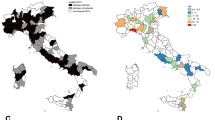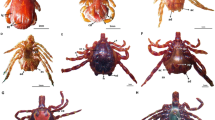Abstract
This study aimed to document the geographic distribution of Ixodes tick species in dogs and the prevalence of Borrelia burgdorferi s.l. in adult ticks and blood samples by amplification of the ospA region of the B. burgdorferi genome. The study area included nine localities in Nuevo León state. DNA amplification was performed on pools of ticks to calculate the maximum likelihood estimation (MLE), and the community composition (prevalence, abundance, and intensity of infestation) was recorded. A total of 2,543 adult ticks, representing four species, Rhipicephalus sanguineus, Dermacentor variabilis, Rhipicephalus (Boophilus) annulatus, and Amblyomma cajennense, were recorded from 338 infested dogs. Statistically significant correlations were observed between female dogs and infestation (P = 0.0003) and between R. sanguineus and locality (P = 0.0001). Dogs sampled in Guadalupe and Estanzuela were positive by PCR (0.9 %) for B. burgdorferi. Rhipicephalus sanguineus had the highest abundance, intensity, and prevalence (10.57, 7.12 and 94.6, respectively). PCR results from 256 pools showed that four pools were positive for D. variabilis (1.6 %), with an MLE of 9.2 %; nevertheless, it is important to consider that in the area under examination probably other reservoir hosts for D. variabilis and B. burgdorferi are present that, very likely, play a much more important role in the ecology of Lyme borreliosis than dogs, which could be considered in future studies.


Similar content being viewed by others
References
Amerasinghe FP, Breish WL, Azad AF, Gimpel WF, Grep M, Weidhart K, Pagac B, Piesman J, Sandt J, Scott TW, Sweeney K (1992) Distribution, density and Lyme disease spirochete infection in Ixodes dammini (Acari: Ixodidae) on white tailed deer in Maryland. J Med Entomol 29:54–61
Anderson JF, Johnson RC, Magnarelli LA, Hyde FW (1985) Identification of endemic foci of Lyme disease: isolation of Borrelia burgdorferi from feral rodents and ticks (Dermacentor variabilis). J Clin Microbiol 22:36–38
Arong GA, Shitta KB, James-Rugu NN, Effanga EO (2011) Seasonal variation in the abundance and distribution of ixodid ticks on mongrel, alsatian, and mixed breeds of dogs (Canis familiaris) in Jos, in Plateau state, North-central Nigeria. World J Sci Technol 1(4):24–29
Bermúdez S, Miranda R, Zaldívar Y, González P, Berguido G, Trejos D, Pascale J, Labruna M (2012) Detección de Rickettsia spp. en ectoparásitos de animales domésticos y silvestres de la Reserva Natural Privada Cerro Chucantí y comunidades aledañas, Panamá, 2007–2010. Biomédica 32:189–195
Biggerstaff BJ (2009) PooledInfRate, Version 4.0: a Microsoft® Office Excel© Add-Into compute prevalence estimates from pooled samples. Centers for Disease Control and Prevention, Fort Collins
Bush AO, Lafferty KD, Lotz JM, Shostak AW (1997) Parasitology meets ecology on its own terms: Margolis et al. revisited. J Parasitol 83:575–583
CDC (2013) Lyme disease is caused by the bacterium Borrelia burgdorferi and is transmitted to humans through the bite of infected blacklegged ticks. In 2010, 94% of Lyme disease cases were reported from 12 states Available at: http://www.cdc.gov/lyme/stats/index.html). Accessed 15 Jan 2013
Chien-Ming S, Li-Lian Ch (2002) An OspA-based genospecies identification of Lyme disease spirochetes (Borrelia burgdorferi) isolated in Taiwan. Am J Trop Med Hyg 66:611–615
Chomel B (2011) Tick-borne infections in dogs—an emerging infectious threat. Vet Parasitol 179:294–301
Debárbora VN, Oscherov EB, Guglielmone AA, Nava S (2011) Garrapatas (Acari: Ixodidae) asociadas a perros en diferentes ambientes de la provincia de Corrientes. Argentina. InVet 13(1):45–51
Eisen L, Eisen RJ, Lane RS (2006) Geographical distribution patterns and habitat suitability models for presence of host-seeking ixodid ticks in dense woodland of Mendocino County, California. J Med Entomol 43:415–427
Esposito S, Bosis S, Sabatini C, Tagliaferri L, Principi N (2012) Borrelia burgdorferi infection and Lyme disease in children. Int J Infect Dis. Available at: 10.1016/j.ijid.2012.09.01. Accessed 13 Dec 2012
Fritz CL (2009) Emerging tick-borne diseases. Vet Clin North Am Small Animal Pract 39:265–278
González-Cerón F, Becerril-Pérez CM, Torres-Hernández G, Díaz-Rivera P (2009) Ticks infesting body regions of tropical milking criollo cattle in Veracurz, México. Agrociencia 43:11–19
Gordillo-Perez G, Torres J, Solórzano-Santos F, Garduno-Bautista V (2003) Seroepidemiologic study of Lyme’s borreliosis in Mexico City and the northeast of the Mexican Republic. Salud Publica Mex 45:351–355
Gordillo-Pérez G, Vargas M, Solórzano-Santos F, Rivera A, Polaco OJ, Alvarado L, Muñoz O, Torres J (2009) Demonstration of Borrelia burgdorferi sensu stricto infection in ticks from the northeast of Mexico. Clin Microbiol Infect 15:496–498
Guerrero-Rodríguez E, Lozoya-Saldaña A, Landeros-Flores J (1986) Garrapatas, garrapatas de animales domésticos en el área de influencia de la UAAAN. Universidad Autónoma Agraria “Antonio Narro”. Saltillo, Coahuila. Vol 1. No 4. Mexico
Hanifeh M, Malmasi A, Virtala AMK, Nikbakht-Brujeni GR, Zahraei Salehi T, Rahbari S (2012) Seroprevalence, geographic distribution and risk factor analysis of Borrelia burgdorferi sensu lato in naturally exposed dogs of Iran. Afr J Microbiol Res 6:5353–5361
Illoldi-Rangel P, Rivaldi Ch-L, Sissel B, Trout Fryxell R, Gordillo-Pérez G, Rodríguez-Moreno A, Williamson P, Montiel-Parra G, Sánchez-Cordero V, Sarkar S (2012) Species distribution models and ecological suitability analysis for potential tick vectors of lyme disease in Mexico. J Trop Med. doi:10.1155/2012/959101
Johnson RC, Schmid GP, Hyde FW, Steigerwalt AG, Brenner DJ (1984) Borrelia burgdorferi sp. nov.: etiological agent of Lyme disease. Int J Syst Bact 34:496–497
Landeros-Flores J, Guerrero-Rodríguez E, Sánchez-Vélez V (1999) Garrapatas: Aspectos sobre su biología, morfología, taxonomía y transmisión de enfermedades. Universidad Autónoma Agraria Antonio Narro, 73 pp
Margolis L, Esch G, Holmes J (1982) The use of ecological terms in parasitology (report of an ad hoc committee of the American Society of Parasitologists). J Parasitol 68:131–133
MHLTC (Ministry of Health and Long-Term Care) (2012) Annual report on human cases of Lyme disease in Ontario. Legislative Library, Queen’s Park, Toronto
Morshed MG, Scott JD, Fernando K, Beati L, Mazerolle DF, Geddes G, Durden LA (2005) Migratory songbirds disperse ticks across Canada and first isolation of the Lyme disease spirochete, Borrelia burgdorferi from the avian tick, Ixodes auritulus. J Parasitol 91:780–790
Murrell A, Barker SC (2003) Synonymy of Boophilus Curtice 1891 with Rhipicephalus Koch 1844 (Acari: Ixodidae). Syst Parasitol 56:169–172
NL Unido (2013) Entrevista concedida a los medios de comunicación por el C. Subsecretario de Prevención y Control de Enfermedades, Dr. Ricardo Huerta Gallaga. Available at: http://www.nl.gob.mx/?Article=23783&ArtOrder=ReadArt&P=leerarticulo&Page=1. Accessed at 13 Feb 2013
Nuevo León (2013) Clima en Nuevo León. Available at: http://nl.gob.mx/?P=nl_geografia_climahttp://www.nl.gob.mx/?P=nl_geografia. Accessed 12 Nov 2012
Pejchalová K, Zákovská A, Mejzlíková M, Holouzka J, Dendis M (2007) Isolation, cultivation and identification of Borrerila burgdorferi genospecies from Ixodes ricinus ticks from the city of Brno Czech Republic. Ann Agric Environ Med 14:75–79
Piesman J, Sinsky R (1988) Ability of Ixodes scapularis, Dermacentor variabilis, and Amblyomma americanum (Acari, Ixodidae) to acquire, maintain, and transmit Lyme disease spirochetes (Borrelia burgdorferi). J Med Entomol 25:336–339
Postic D, Garnier M, Baranton G (2007) Multilocus sequence analysis of atypical Borrelia burgdorferi sensu lato isolates—description of Borrelia californiensis sp. nov., and genomospecies 1 and 2. Int J Med Microbiol 297:263–271
Ramírez-Barrios RA, Chacín E, Barboza G, Fernández G, Valera Z, Villalobos A, Angulo-Cubillán F (2008) Garrapatas (Acari: Ixodidae) recolectadas de caninos bajo asistencia veterinaria en Maracaibo Venezuela. Rev Cient (Maracaibo) 13:267–270
Rudenko N, Golovchenko M, Grubhoffer L, Oliver JH Jr (2009) Borrelia carolinensis sp. nov., a new (14th) member of Borrelia burgdorferi sensu lato complex from the southeastern region of the United States. J Clin Microbiol 47:134–141
Salinas-Meléndez JA, Avalos-Ramirez R, Riojas-Valdez VM, Martinez-Muñoz A (1999) Serological survey of canine borreliosis. Rev Latinoam Microbiol 41:1–3
Salinas-Meléndez JA, Galván de la Garza S, Rojas-Valdés VM, Wong-González A, Avalos-Ramírez R (2001) Antibodies detection against Borrelia burgdorferi in horses located in the suburban areas of Monterrey, Nuevo León. Rev Latinoam Microbiol 3:161–164
Scott JD, Lee MK, Fernando K, Durden LA, Jorgensen DR, Mak S, Morshed MG (2010) Detection of Lyme disease spirochete, Borrelia burgdorferi sensu lato, including three novel genotypes in ticks (Acari: Ixodidae) collected from songbirds (Passeriformes) across Canada. J Vector Ecol 35:124–139
Shaw MT, Keesing F, McGrail R, Ostfeld RS (2003) Factors influencing the distribution of larval blacklegged ticks on rodent hosts. Am J Trop Med Hyg 68:447–452
Slider D, Samir P, Curtis R, Jain-Sheehan N, Moore S (2012) PHO: technical report: update on Lyme disease prevention and control. Public Health Ontario. Agency for Health Protection and Promotion. Ontario. Available at: http://www.oahpp.ca/about/whatsnew/PHO-technical-report-update-on-lyme-disease-prevention-and-control.html. Accessed 26 Feb 2013
Spielman A, Clifford CM, Piesman J, Corwin MD (1979) Human babesiosis on Nantucket Island, USA: description of the vector, Ixodes (Ixodes) dammini, n. sp. (Acarina: Ixodidae). J Med Entomol 15:218–234
Stromdahl EY, Evans SR, O’Brien JJ, Gutierrez AG (2001) Prevalence of infection in ticks submitted to the human tick test kit program of the U.S. Army Center for Health Promotion and Preventive Medicine. J Med Entomol 38:67–74
Taragel’ová V, Koči J, Hanincová K, Kurtenbach K, Derdáková M, Ogden NH, Literák I, Kocianová E, Labuda M (2008) Blackbirds and song thrushes constitute a key reservoir of Borrelia garinii, the causative agent of borreliosis in central Europe. Appl Environ Microbiol 74:1289–1293
Tinoco-García L, Quiroz-Romero H, Quintero-Martínez MT, Rentería-Evangelista TB, Barreras-Serrano A, Hori-Oshima S, López-Valencia G, Tamayo-Sosa AR, Medina-Basulto G, Haro-Alvarez P, Moro M, Vinasco J (2009) Prevalence and risk factors for Borrelia burgdorferi infection in dogs of animal control centers from Mexicali, Baja Californina: a Mexico-US Border City. J Anim Vet Adv 8:251–254
Tsao JI (2009) Reviewing molecular adaptations of Lyme borreliosis spirochetes in the context of reproductive fitness in natural transmission cycles. Vet Res 40:36. doi:10.1051/vetres/2009019
Acknowledgments
We gratefully acknowledge the contributions of Biol. Cuauhtémoc Lara and Biol. Andrés Alvarez, who performed the field work. In addition, special thanks to Mariana Cinco (Dipartimento di Scienze Biomediche Sez. Microbiologia Universita` degli Studi Trieste, Italy) and Mario T. Philipp (Division of Bacteriology and Parasitology, Tulane National Primate Research Center), who kindly provided us with positive controls for B. burgdorferi DNA. This project was supported by PAICYT-UANL 2012.
Author information
Authors and Affiliations
Corresponding author
Rights and permissions
About this article
Cite this article
Galaviz-Silva, L., Pérez-Treviño, K.C. & Molina-Garza, Z.J. Distribution of ixodid ticks on dogs in Nuevo León, Mexico, and their association with Borrelia burgdorferi sensu lato. Exp Appl Acarol 61, 491–501 (2013). https://doi.org/10.1007/s10493-013-9707-5
Received:
Accepted:
Published:
Issue Date:
DOI: https://doi.org/10.1007/s10493-013-9707-5




